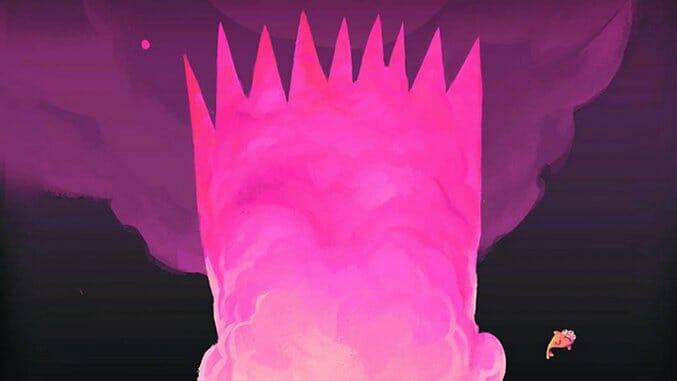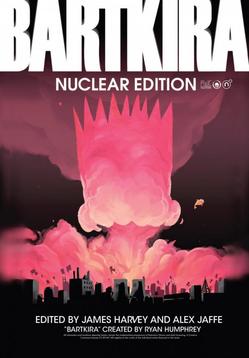Pop-Culture Influences Explode in the Gonzo Bartkira: Nuclear Edition
Cover Art by Mike O'Brien Comics Reviews
Editors: James Harvey & Alex Jaffe
Release Date: April 27, 2016
 How the hell does one describe Bartkira? The simplest definition is often the best: a collaborative campaign comprised of over 700 artists across the globe, brought together to reinterpret all six volumes of Katsuhiro Otomo’s manga opus, Akira, through the characters and set pieces of Matt Groening’s landmark animated sitcom, The Simpsons. This endeavor, by its very nature, prompts half-cocked eyebrows and bewildered expressions from even the most savvy Japanese comic enthusiasts; it’s a product so cockamamie that it seems all but certain to succeed by its sheer absurdity.
How the hell does one describe Bartkira? The simplest definition is often the best: a collaborative campaign comprised of over 700 artists across the globe, brought together to reinterpret all six volumes of Katsuhiro Otomo’s manga opus, Akira, through the characters and set pieces of Matt Groening’s landmark animated sitcom, The Simpsons. This endeavor, by its very nature, prompts half-cocked eyebrows and bewildered expressions from even the most savvy Japanese comic enthusiasts; it’s a product so cockamamie that it seems all but certain to succeed by its sheer absurdity.
With four of the six volumes fully reimagined, key selections from the project’s free online archive have been collected as a special hardcover dubbed Bartkira: Nuclear Edition. The proceeds of the volume are split between two charities: The OISCA Coastal Forest Restoration Project in Miyagi Prefecture (home of Akira creator Otomo), and Save the Children (Simpsons co-creator Sam Simon’s charity of choice). The book itself is a triumphant work of postmodernist mash-up culture, a lovingly curated art project designed to foster creativity within the global comic community, and an homage to two of the most monolithic properties of the late 20th century.

Bartkira Interior Art by Cameron Stewart
Much in the way that the characters and locations of The Simpsons seamlessly exist alongside the scenarios and existential perils of Akira’s Neo-Tokyo, a surprising aura of quiet wisdom permeates the quirk of Bartkira’s appeal. This juxtaposition of sentiments is beautifully summarized in David Surman’s foreword, accrediting its conception to the mercurial online art culture of the early 21st century—a time signifying great uncertainty, the blurring of mediums, the shrinking and expanding aperture of tastes and taboos. More importantly, this culture redrew the line between art and homage. These conditions also resemble the radical reinvention of Japan’s own cultural identity in the mid-‘70s, when industrial economic stability and political dissent became the aesthetic backdrop of Otomo’s sequential masterwork.
Bartkira’s ulterior objective is audacious, siphoning the raw, irreverent potential of the Internet to close the gap between comic industry veterans and anxious newcomers, allowing them to concentrate their combined talent into one project. That goal not only shares a reverence for Akira’s legacy, but inspires future generations to commit themselves to the creation and, most importantly, the completion of new projects that may serve as the spiritual torchbearers of Akira’s precedent. What took Otomo eight years to conceive and accomplish, the collective Bartkira community has re-imagined in nearly half the time. Who knows what profound new creations a fraction of these artists will imagine? The spirit of Akira is alive and well in the year 2016.
-thumb-500x375-452609.jpg)
Bartkira Interior Art by Walder Johan
The book’s reinterpretations of the original manga toe the line between playful self-reference and an anarchic sense of gallows humor. Marigold Bartlett exemplifies this contrast, featuring a mass exodus of citizens fleeing the ruins of Neo-Springfield, frenzied by the psychic backlash of Ralph Wiggum’s (in the role of Akira) grief. The survivors clamor for salvation and refuge outside the doors of Lisa Simpson’s Buddhist temple compound, an inspired mash-up of Lady Kiyoko’s monastery from the original manga and Reverend Lovejoy’s First Church of Springfield. Lisa’s fatalistic catch phrase of “Embrace Nothingness” (from the 1991 Simpsons arcade game) stretches across the church’s announcement board, bolstering the scene’s existential gravitas to such madness and dread that it rivals the grim severity of Otomo’s original.
As much as Bartkira relishes its tongue-in-cheek take on Akira’s tropes, it knows when to pull back on the jokes. Walder Johan’s contributions are a perfect example of this restraint; his yawning, nuclear devastation of Neo-Springfield is almost entirely absent of the Easter egg iconography present throughout the rest of the book.

Bartkira Interior Art by Marigold Bartlett
Bartkira stands as a testament to the dogged ambition that Akira’s narrative embodies, the resiliency of the human spirit when faced with seemingly insurmountable despair. And the source material has certainly inspired similar acts of full-blooded homage: Bwana’s Capsule’s Pride remixes the Akira motion picture’s original score into a frenetic EDM-infused mixtape; a gallery exhibition of 42 artists paid tribute to Otomo’s work earlier this year in Paris; and rumblings have emerged of a possible Akira-related TV series from none other than Katsuhiro Otomo himself. The commercial release of Bartkira: Nuclear Edition is not just a well-curated art project, but one of many indications of the mass resurgence of Otomo’s magnum opus in the public eye, and its fixture in the zeitgeist of 21st-century pop culture.
Bartkira: Nuclear Edition is available to order at Floating World Comics.